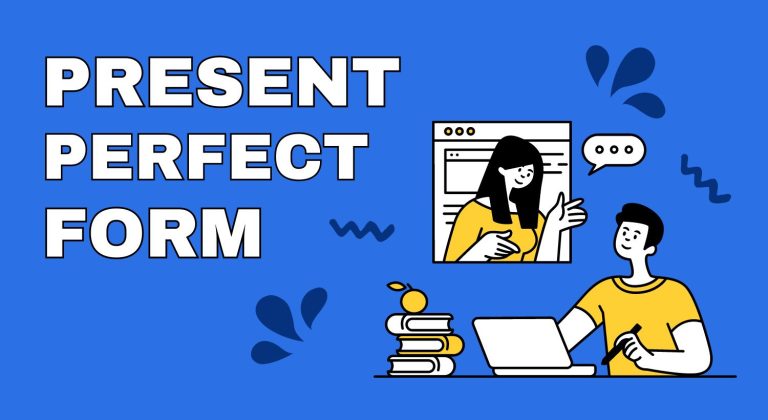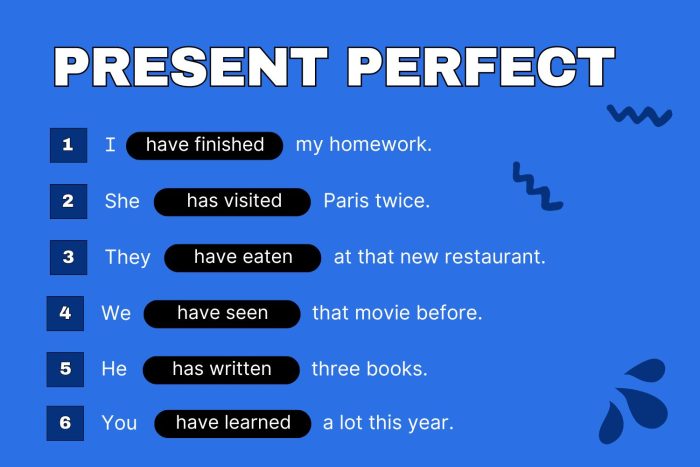Present Perfect Tense

Present Perfect Form
As mentioned, the present perfect shows that something happened before but still affects us now. We make it with “have” or “has” and the main verb’s past form.
Here is the form to use for present perfect:
Positive = Subject + have/has + verb + object
Negative = Subject + have/has + verb + object
Question = Have/has + subject + verb + object?
The present perfect form mixes past and present. It uses “have” or “has” with a verb’s past part to show actions affecting now.
This form is useful for actions that happened at an unknown time before now. It helps us talk about our experiences and changes that matter today.
Here are some examples of the present perfect tense.
Positive = She has completed the mission.
Negative = She has not completed the mission.
Question = Has she completed the mission?
Here’s what each of these present perfect examples means:
- “She has completed the mission.” This means the mission is finished now.
- “She has not completed the mission.” Here, it tells us the mission is still ongoing.
- “Has she completed the mission?” This question asks if the mission is finished or not.
So, these examples show how we can talk about finished actions and ongoing situations. We can also ask using the present perfect form.
Present Perfect Tense Examples
The present perfect tense helps us talk about things that happened in the past but still matter now. It connects our past actions to the present moment.
Here are more examples to show how the present perfect tense works.
1. I have finished my homework.
2. She has visited Paris twice.
3. They have eaten at that new restaurant.
4. We have seen this movie before.
5. He has written 3 books.
6. You have learned a lot this year.
Let’s go through each of these examples and how they work with the present perfect tense.
- “I have finished my homework.” – This means I’m done with homework and can do other things now.
- “She has visited Paris twice.” – She’s been to Paris two times, which adds to what she’s experienced.
- “They have eaten at that new restaurant.” – They’ve tried the restaurant, so it might change where they eat next.
- “We have seen this movie before.” – We watched the movie already, so we might choose another.
- “He has written 3 books.” – He finished three books, making him an author.
- “You have learned a lot this year.” – You’ve gained a lot of knowledge this year, meaning you’re smarter now.
Now that you have some examples, let’s take a look at when and how we would use the present perfect form.

When and How to Use the Present Perfect Tense
We use the present perfect tense to connect past actions to the present moment. By using “have” or “has” with the past participle of a verb, this shows the completion of the present.
Here are 4 situations that we typically use present perfect:
Let’s look at examples of using the present perfect tense in these situations.
1. Experience
When we use the present perfect tense for “experience,” it means we’re talking about things we’ve done at some point in our lives. This tense highlights the experience itself without specifying the timing of it.
For example, saying “I have visited New York” tells someone you’ve had the experience of visiting New York. But the focus isn’t on when you went. It suggests that experience is important and might relate to the present in some way.
2. Unfinished Actions
We use the present perfect tense for actions that started in the past and are still going on. It shows how long the action has been happening. But it also means that it’s still important today.
For instance, let’s use the sentence “I have lived here for 20 years”. This sentence shows the action of living in a place that started 20 years ago and is still happening now. Unfinished actions show that what started in the past is ongoing today.
3. Recently Completed Actions
We use the present perfect tense for actions that were completed very recently. This helps show that something happened a short time ago, affecting the present moment.
For example, let’s use the sentence, “She has just arrived at the station”. This means she arrived not long ago and is probably still there or nearby. This highlights how recent the action is and why it matters now.
4. Results Of Past Action
The present perfect tense can also show the results of past actions that affect the present. It helps us understand that something done in the past has effects we can see or feel now.
For instance, saying “I have eaten too much” suggests that the action of eating too much happened before now. Its result leads to the decision “I should start a diet.” This use of the tense links past actions with their present outcomes.
Present Perfect Tense
The present perfect tense is one of the 12 verb tenses in English. It’s useful because it connects past actions to now. It shows our experiences, things still happening, recent events, and their effects.
So, when we talk about what we’ve done, like finishing homework, or places we’ve visited, we use this tense. It helps us explain how past actions matter today.
Do you have any examples of when you’ve used the present perfect tense? We’d love to hear from you in the comment section below.

